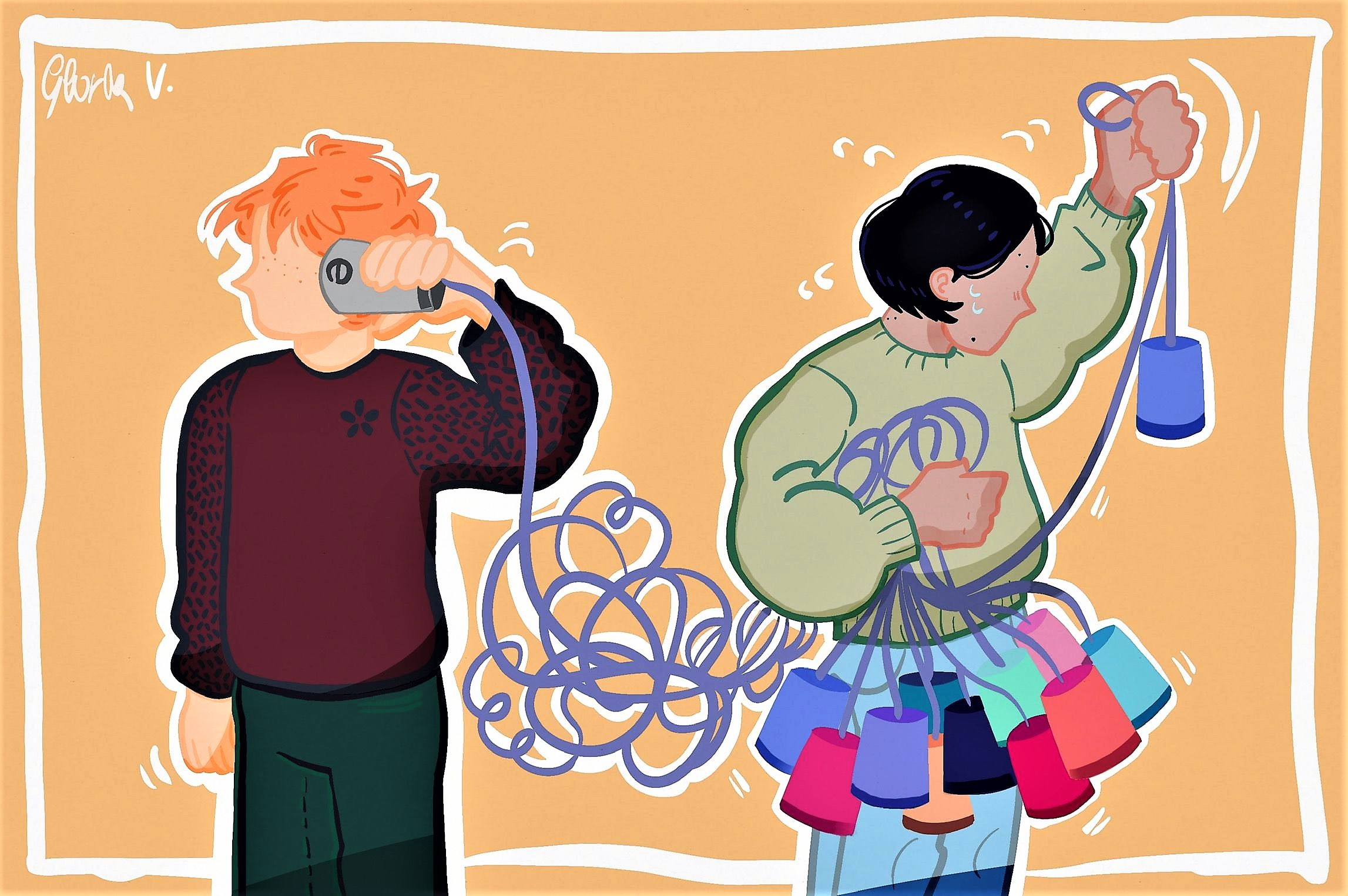Un linguaggio neutro
by Gloria Vertecchi (2006) Liceo Sesto Properzio, Assisi/Italy on 2023-05-29

The following article was written by Gloria Vertecchi (2006), Liceo Sesto Properzio di Assisi/Italy, Angelo Pettirossi (2005), Liceo Sesto Properzio di Assisi/Italy, and Giulia Hasmüller (2008), Gisela-Gymnasium München/Germany,
as part of the trait d`union online workshop “The fight against discrimination and the discussion on how to” between editors from Liceo Sesto Properzio di Assisi/Italy and Gisela-Gymnasium München/Germany in March 2022.
Gloria Vertecchi created the picture.
Un linguaggio neutro
Attualmente le lingue ufficiali di tutto il mondo sono 141, con un’origine e un’evoluzione che ha permesso ad alcune di diventare più neutre di altre rispetto al genere.
Nella maggior parte delle lingue contemporanee vengono utilizzati i pronomi “lui” e “lei” i quali identificano rispettivamente un individuo di sesso maschile e uno di sesso femminile.
A tal proposito la questione recente riguarda proprio la possibilità di introdurre un pronome neutro in grado di identificare il genere non binario, ovvero dare una voce a chi non si riconosce in nessuno dei due generi sopra menzionati; inoltre il riconoscimento di diverse identità sessuali accentua notevolmente una diatriba alla quale si cerca di porre rimedio.
Per quanto riguarda la lingua scritta, nel corso del tempo si è cercato di introdurre un genere neutrale attraverso varie strategie: una di queste consiste ad esempio nell’utilizzo dell’asterisco che consente di troncare le desinenze maschili e femminili.
Un altro metodo è la chiocciola, un simbolo che può essere impiegato per comprendere sia il maschile che il femminile che però non considera le persone senza genere non permettendo allo stesso tempo di troncare le parole ma solamente di sostituire le desinenze femminili e maschili con la @.
La lettera -x viene considerata una consonante misteriosa che nella lingua inglese è impiegata per rendere le parole neutrali, e nel caso di parole declinabili perchè derivanti da lingue di genere binario.
Alcuni paesi hanno deciso di concedere l’impiego della lettera -x in documenti amministrativi per le persone intersex o non binarie. Si tratta di una lettera che per essere usata non necessita di alcuna spiegazione ma risulta difficile nella sua pronuncia senza ricorrere alla i fonetica prima della -x.
Infine un ulteriore metodo è rappresentato dall’utilizzo dello schwa (Ə) che è un suono secco, definito “e muta”.
L’utilizzo dello schwa comporta però un problema in quanto la maggior parte delle persone non comprende che si tratta di una forma neutra. Nonostante ciò con il passare del tempo potrebbe diventare di uso comune e garantire pertanto una maggiore inclusività per le persone dal punto di vista linguistico.
Com’è possibile dunque trovare una soluzione idonea a questo problema nella lingua parlata?
Anche se è importante definire una soluzione idonea a tale argomento, non bisogna dimenticare il patrimonio linguistico che ogni paese e ogni cultura possiede, che si è sviluppato ed imposto nel tempo e che definisce non solo il luogo in cui viene usato ma anche le persone che tra di loro comunicano con la lingua stessa.
Sarebbe dunque un problema se, per dare spazio a una rivoluzione linguistica, si andasse ad intaccare ciò che viene considerato il carattere distintivo di una popolazione.
Non è possibile pensare di eliminare le radici e la progressione che si è avuta durante i secoli e il ruolo che la lingua ha avuto nella società fino ad oggi, ma è necessario cercare di mitigare la cosa in maniera equa dato che così facendo si può contribuire allo sviluppo della lingua parlata, che serve tutti i giorni e deve riuscire a cambiare e stare al passo con una società che attualmente presenta nuovi tipi di necessità di espressione.
Utilizzando la x, l’asterisco, la chiocciola o lo schwa in contesti legati alla genderizzazione della lingua si vanno a opacizzare le desinenze maschili e femminili, potendo ricorrere alla possibilità di pronomi diversi da lui-lei e di riferirsi a una persona che differisce dai due generi recuperando il neutro, genere grammaticale solitamente usato per persone non binarie, transessuali o che non si identificano in quelli che sono i pronomi maschili o femminili. Questa forma di rispetto anti-sessista è quindi degna di considerazione poiché, evitando l’uso del maschile attualmente previsto dalla normativa, fa riferimento a entrambi i generi.
Nella lingua parlata quest’uso sarebbe molto sconveniente poichè l’effetto risulterebbe molto simile a quello di un modulo burocratico con doppie uscite maschili e femminili suddivise dalla barra. Inoltre nel testo scritto l’asterisco viene usato dall’autore per omettere qualcosa, per censurare, o per rinviare a una nota ai piedi di una pagina. Sarebbe quindi abbastanza difficile da pronunciare e bisognerebbe tagliare fuori le finali facendo sembrare la parola mozzata e talvolta insensata.
Scelta migliore potrebbe essere allora lasciar stare soluzioni che riducono la leggibilità e la praticità di un discorso come sbarre o parentesi o altri tipi di lettere aggiuntive che andrebbero solamente a intaccare ciò che si vuole dire.
Anche se a questo punto il problema continuerà a persistere è bene ricordarsi che lo scopo di un linguaggio inclusivo e non discriminatorio non è quello di rendere radicale ogni traccia del genere maschile o femminile dalla lingua parlata, infatti il maschile al posto del neutro ha una funzione pratica ed è spesso difficile o addirittura impossibile da evitare a meno che non si adottino metodi non ancora accettati nella norma linguistica come ad esempio lo schwa (ə). La soluzione più gettonata rimane dunque quella di troncare le parole per omettere il genere a cui ci si sta riferendo cercando appunto di essere il più neutro possibile non andando quindi a intaccare quelle che potrebbero essere le disuguaglianze o trascuratezze rispetto al proprio interlocutore.
L’italiano non è l’unica lingua che sta avendo complicazioni per quanto riguarda l’inclusione di generi di cui si sta parlando negli ultimi decenni: anche nella lingua tedesca, sono state prese delle misure per evitare discriminazioni di genere.
Un altro sostanziale cambiamento a livello linguistico è l’ iniziativa di riformare anche il dizionario di lingua tedesca - il più famoso, il Duden - modificando migliaia di voci di professioni che non saranno più indicate solo nella forma maschile, come è sempre stato fino ad ora: ad essere inclusi in questo cambiamento saranno circa 12.000 termini.
Per citare altri usi del neutro per non indicare il genere di cui si sta parlando, l’inglese è una delle lingue più avvantaggiate che si dimostra molto più adattabile a questa situazione che è diventata un nodo cruciale del linguaggio tanto che oggi giorno in assenza di termini neutri per indicare i ruoli detenuti da donne e da uomini si preferisce indicare la mansione generica. Questo generalmente non è un problema nella lingua inglese, favorita rispetto alle altre lingue perché nomi e aggettivi non hanno il maschile e il femminile, esattamente come gli articoli. Infatti per individuare il genere sono essenziali i pronomi, alcuni specifici termini che indicano mansioni professionali o, in altri casi, appellativi.
Abbiamo inoltre la presenza del “they” singolare, ovvero un pronome neutro che viene sempre più usato e che può riferirsi ad singola persona, senza classificarla.
A gender-neutral language
There are currently 141 official languages around the world, each with a different origin and an evolution that has allowed some to become more gender neutral than others.
In most contemporary languages the pronouns "he" and "she" are used to identify a male and a female individual, respectively.
In this regard, a recent issue is precisely the possibility of introducing a neutral pronoun able to identify the non-binary gender, or give a voice to those who do not recognize themselves in either of the two genders mentioned above; also, the recognition of different sexual identities greatly accentuates the debate, which must be given an answer.
As far as written language is concerned, over time people have tried to introduce the neutral gender through various strategies: one of these is, for example, the use of the asterisk, which allows to apocopate masculine and feminine endings.
Another method is the @, a symbol that can be used to include both masculine and feminine, but does not consider people without gender, not allowing at the same time to apocopate words but only to replace feminine and masculine endings with the @.
The letter -x is considered a mysterious consonant that in the English language is used to make words neutral, and also when words are declined because they originate from binary gender languages.
Some countries have decided to allow the use of the letter -x in administrative documents for intersex or non-binary people; it is a letter that needs no explanation to be used but is
difficult to pronounce without using the phonetic ‘i’ before the -x.
Finally, another method is the use of schwa (Ə) which is a dry sound defined as "silent e". However, the use of schwa poses a problem as most people do not understand that it is a neutral form, despite this with the passage of time it could become commonly used and therefore ensure greater inclusiveness from a linguistic point of view.
So how is it possible to find a suitable solution to this problem in the spoken language?
Although it is important to define a worthy conclusion to this argument, we must not forget the linguistic heritage that every country and every culture possess, which has developed and imposed itself over time and which defines not only the place where it is used but also the people who communicate with each other through the language itself.
It would therefore be a problem if, in order to make room for a linguistic revolution, we were to undermine what is considered a distinctive feature of a population.
It is not possible to think of abolishing the roots and the development that has taken place over the centuries and the role that a language has had in society until today, but it is necessary to try to mitigate this in an equitable manner since by doing so we are also
making a contribution to the development of everyday speech keeping up with a changing society, that currently has new linguistic needs.
By using the x, the asterisk, the @ or the schwa in contexts related to the genderization of the language, the masculine and feminine endings are dulled, making it possible to use pronouns other than he/she and to refer to a person who differs from the two genders, recovering the neutral form, grammatical gender normally used for non-binary, transsexuals or people who do not identify with the grammatical masculine or feminine pronouns.
This form of anti-sexist respect is therefore worthy of consideration since, avoiding the use of masculine, currently provided by the regulations in this regard, it refers to both genders.
In the spoken language it would be very inconvenient since the effect is very similar to that of a bureaucratic form that recalls the double masculine and feminine exits divided by a slash. Also, in the texts the asterisk is often used by the author either to omit something, to censor, or to refer to a note at the foot of a page, so it would be quite difficult to pronounce these terms and it would be necessary to cut out the endings making the word sound senseless.
A better choice would be to leave out solutions that reduce the readability and practicality of a speech, such as bars or brackets or other types of additional letters, that would only affect what you want to say.
Even if at this point the problem will continue to persist, it is good to remember that the purpose of an inclusive and non-discriminatory language is not to make a radical discarding of any trace of male or female gender from the spoken language: in fact the masculine, instead of the neutral, has a practical function and is often difficult or even impossible to avoid unless you adopt methods not yet accepted in the linguistic norm such as schwa (ə). The most popular solution is therefore the recurrence of words apocope to omit the gender we are referring to, trying to be as neutral as possible without affecting what could be the inequalities or neglect of the will of the interlocutor.
Italian is not the only language that is having complications in terms of gender inclusion: also in the German language it has been necessary to take measures and start avoiding gender discrimination.
Another substantial change at linguistic level is the initiative to reform also the German language dictionary - the most famous, the Duden - modifying thousands of entries of professions that will no longer be indicated only in the masculine form, as it has always been until now: to be included in this change will be about 12,000 terms.
To name other uses of the neutral form in a language in order not to indicate the gender of what we are talking about, we can mention English, one of the most advantaged languages, which proves to be extremely adaptable to this situation (that has become a crucial node for language as much as for society values) so much that nowadays in the absence of neutral terms to indicate the roles held by women and men it is preferred to indicate the generic job: this generally, in the English language, is not a problem since it is favored over other languages because adjectives do not have masculine and feminine forms, just like articles. In fact to identify the gender, what’s really essential are the pronouns of some specific terms that indicate professional tasks or in other cases appellatives.
We also have the presence of the "they singular", a neutral pronoun that has been increasingly used to refer to a single person, without categorizing.
Sources:
https://www.isnews.it/2021/07/20/gender-neutral-nella-lingua-tedesca/
https://www.tdm-magazine.it/linguaggio-inclusivo-in-italiano-guida-pratica/




